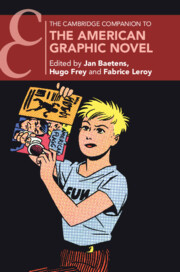Book contents
- The Cambridge Companion to the American Graphic Novel
- The Cambridge Companion to the American Graphic Novel
- Copyright page
- Contents
- Figures
- Contributors
- Editors’ Acknowledgments
- Introduction
- Part I History and Genre
- 1 The “First” Graphic Novel in America
- 2 The Mad-Men Generation
- 3 From Justin Green and Art Spiegelman to Alison Bechdel
- 4 Graphic Journalism
- 5 “Great” American Graphic Novels
- 6 Crime
- 7 Superheroes in Graphic Novels
- 8 Science Fiction and Fantasy
- 9 “Scared Witless”
- Part II Graphic Novels and the Quest for an American Diversity
- Index
- Cambridge Companions To …
- References
1 - The “First” Graphic Novel in America
Revisiting He Done Her Wrong and It Rhymes with Lust
from Part I - History and Genre
Published online by Cambridge University Press: 10 January 2024
- The Cambridge Companion to the American Graphic Novel
- The Cambridge Companion to the American Graphic Novel
- Copyright page
- Contents
- Figures
- Contributors
- Editors’ Acknowledgments
- Introduction
- Part I History and Genre
- 1 The “First” Graphic Novel in America
- 2 The Mad-Men Generation
- 3 From Justin Green and Art Spiegelman to Alison Bechdel
- 4 Graphic Journalism
- 5 “Great” American Graphic Novels
- 6 Crime
- 7 Superheroes in Graphic Novels
- 8 Science Fiction and Fantasy
- 9 “Scared Witless”
- Part II Graphic Novels and the Quest for an American Diversity
- Index
- Cambridge Companions To …
- References
Summary
This chapter deals with two long-form narratives that can be considered forerunners of the graphic novel: Milt Gross’s He Done Her Wrong (1930) and Drake Waller, Matt Baker, and Ray Osrin’s It Rhymes with Lust (1950). It stresses the originality of these proto-graphic novels and offers a close reading of both works, while reexamining their connections with other visual forms, namely, slapstick comedy, the woodcut novel, and film noir. To propel his dynamic story forward, Gross developed new ways of experimenting with the shape of panels, their size (as defined by the frames that delimit them), and their site (their particular placement within the space of the page). The chapter also addresses issues of gender and studies the critical treatment of male and female stereotypes. Finally, it studies the representation of graphic violence, reading It Rhymes with Lust as an example of “soft noir.”
Keywords
- Type
- Chapter
- Information
- The Cambridge Companion to the American Graphic Novel , pp. 19 - 37Publisher: Cambridge University PressPrint publication year: 2023

